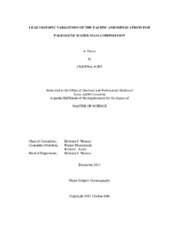| dc.description.abstract | To understand the effects changes in the meridional overturning circulation (MOC) played on past climate we need to determine where convection occurred. The late Cretaceous and early Paleogene interval (~75 to 35 Ma) was characterized by low meridional temperature gradients. Nd isotopes indicate high-latitude convection in the Pacific Ocean during this interval, with deep waters mixing in the tropical Pacific. Here we investigate the evolution of the Pb isotopic composition of water masses in the Pacific to constrain variability in weathering inputs into the inferred convection regions from ~75 to 35 Ma. We generated ^(206),^(207),^(208)Pb/^(204)Pb isotope records for North Pacific DSDP and ODP Sites 192, 464, and 883, and South Pacific DSDP Sites 323, 463, and 596.
South Pacific deep waters increasing in contributions. Pb composition in the subtropical South Pacific also suggests a stronger influence of dust dissolution whereas the Nd composition was dominated by water mass composition. North Pacific Pb values may also have reflected shifting sources during the EECO. The Pb and Nd composition at Site 883 shows a short radiogenic excursion in Pb values ~40 Ma, possibly cased by a short period of strengthened North Pacific Deep Water (NPDW) influence on the isotopic composition during the Mid-Eocene Climatic Optimum (MECO).
^(206)Pb/2^(04)Pb trends differ from ^(207),^(208)Pb/^(204)Pb values, which typically show similar trends to each other—resulting from the mixing of multiple Pb sources. North Pacific sites typically exhibit relatively lower Pb compositions than South Pacific, and evidence from detrital analyses suggests sources of Pb to North Pacific sites received strong contributions of continental dust. Pb and Nd are coupled in North Pacific sites between ~62 and 50 Ma, as well as in the Southern Ocean throughout the study period, indicating the Pb composition in this region was influenced by the composition of advected deep water masses. North Pacific sites also show decoupling of Pb and Nd ~50 Ma, during the Early Eocene Climatic Optimum (EECO), which may be indicative of more distal | en |


